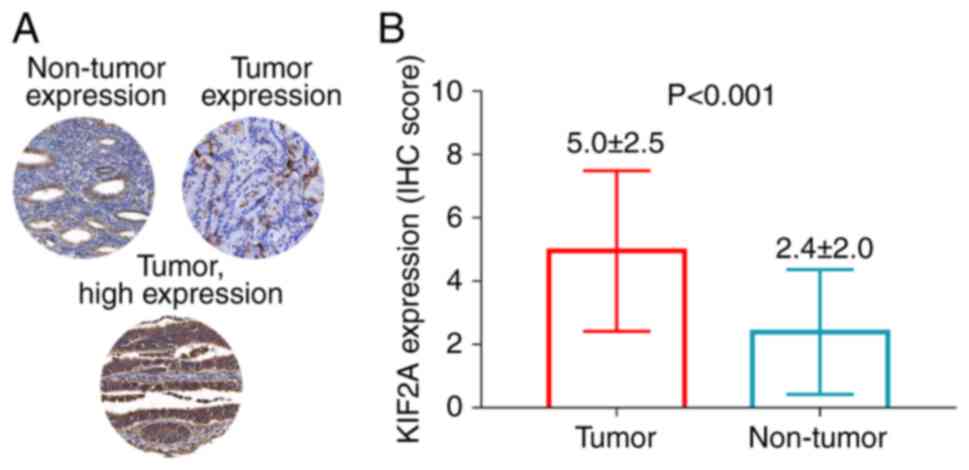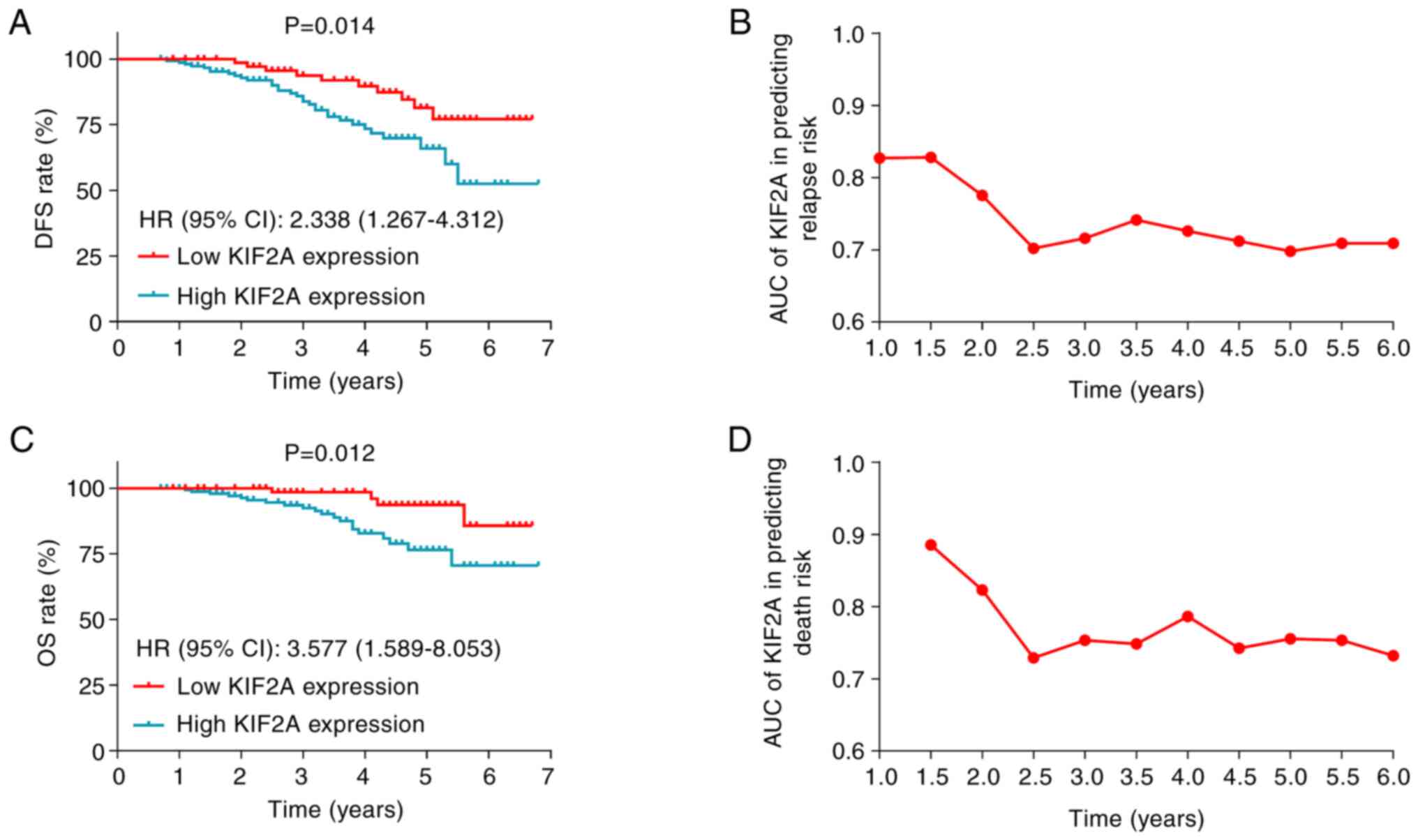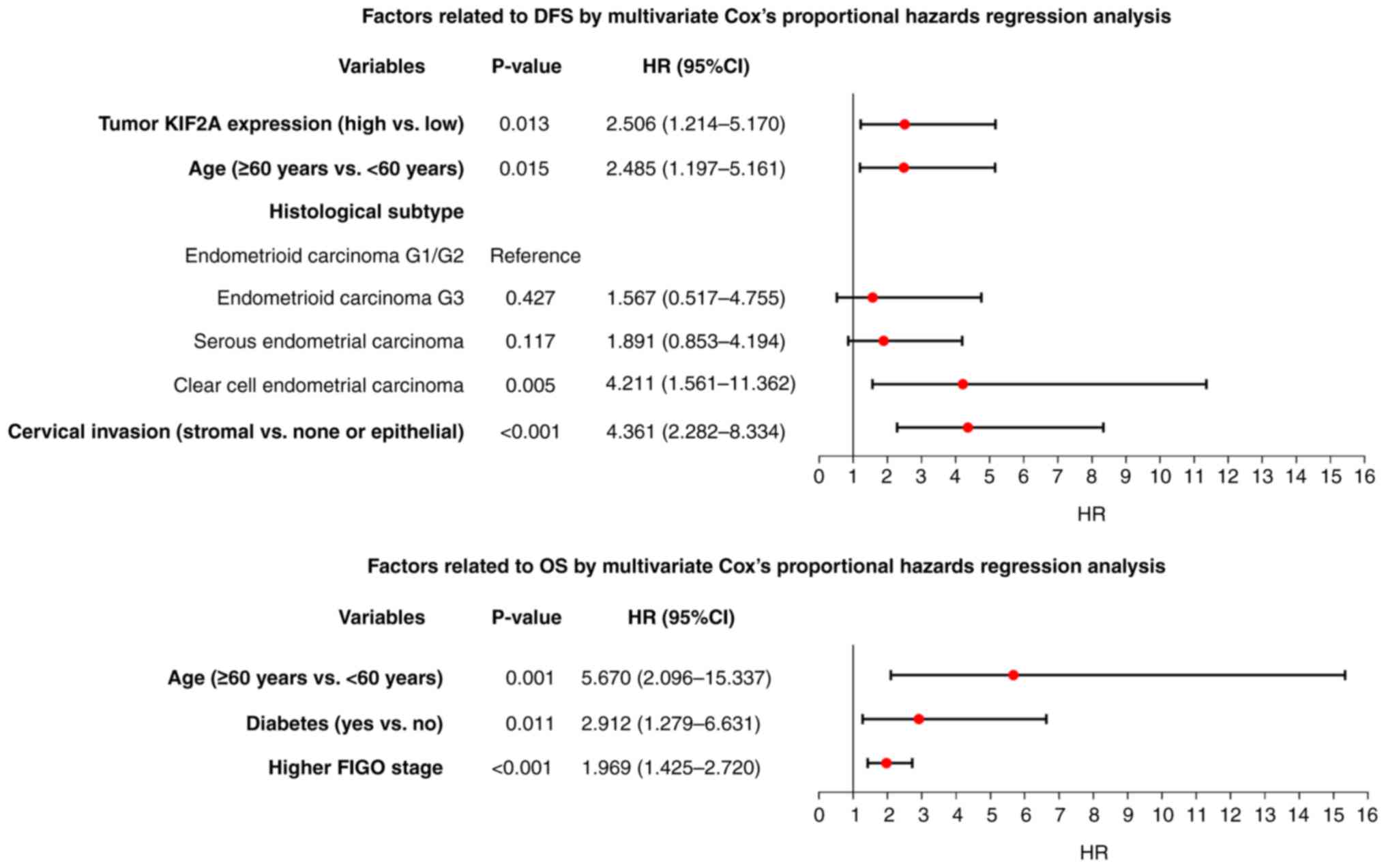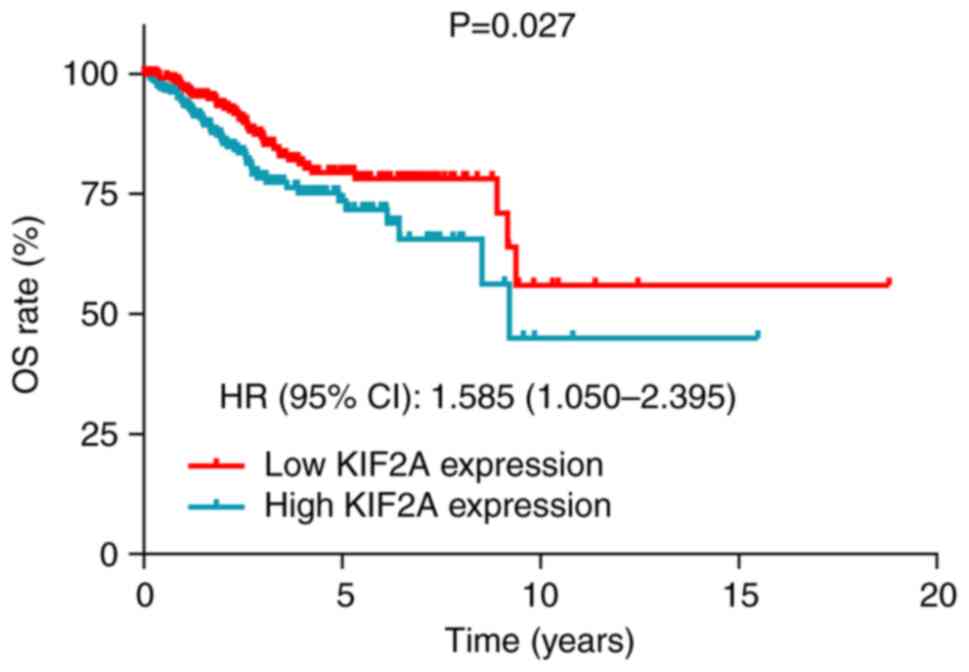KIF2A correlates with lymphovascular invasion and higher tumor stage, and can be used to predict worse prognosis in patients with endometrial carcinoma
- Authors:
- Published online on: June 25, 2024 https://doi.org/10.3892/ol.2024.14529
- Article Number: 396
-
Copyright: © Shi et al. This is an open access article distributed under the terms of Creative Commons Attribution License.
Abstract
Introduction
Endometrial carcinoma (EC) is one of the most prevalent female genital tract malignancies worldwide (1–3). In 2019, the incidence rate of EC was 6.39 per 100,000 people in China and this is increasing (4). The standard treatment strategy for patients with EC is surgery, after which the decision to receive adjuvant radiotherapy or chemotherapy is made based on the patient's disease condition (5–8). Currently, some advances have been made in establishing a consensus on risk classification for EC, which is beneficial for best-tailored management to improve the prognosis of patients with EC (9,10). However, as a clinically heterogeneous disease, there are still certain patients with EC whose survival is unsatisfactory (11–13). Thus, identifying potential biomarkers for the stratified management of EC is vital.
Kinesin family protein 2A (KIF2A) is a member of the kinesin-13 family that functions by restraining the process of microtubule polymerization and is considered to participate in the progression of a variety of tumors, including gynecological cancers (14–17). For example, one study showed that KIF2A promotes the migration and invasion of cervical cancer cells (14). Additionally, another study suggested that the overactivation of KIF2A induces the depolymerization of microtubules, thereby promoting the progression of epithelial ovarian cancer (15). Clinically, a previous study indicated that KIF2A expression was elevated in tumor tissues compared with non-cancerous tissues, and high KIF2A expression was associated with unsatisfactory overall survival (OS) in patients with epithelial ovarian cancer (18). Additionally, another study indicated that KIF2A serves as a potential biomarker for disease monitoring and prognostication in patients with cervical cancer (19). However, to the best of our knowledge, the clinical role of KIF2A as a potential biomarker in patients with EC has not been previously investigated.
Therefore, the present study aimed to evaluate KIF2A expression as well as its correlation with prognosis in patients with EC.
Materials and methods
Patients
A total of 230 patients with EC who underwent surgical resection in Handan Central Hospital (Handan, China) between January 2015 and December 2019 were retrospectively screened. The inclusion criteria were as follows: i) EC diagnosis by histopathological examination; ii) ≥18 years of age; iii) underwent surgical resection; iv) accessible and available tumor formalin-fixed paraffin-embedded (FFPE) specimens; and v) adequate clinical characteristics data and information for at least one follow-up. Patients who had other malignancies, were pregnant or were lactating were excluded. The present study was approved by the Ethics Committee of Handan Central Hospital (approval no. 2023020615; Handan, China), and informed consent (written or oral) was obtained from every patient or their family member.
Sample collection
Data on demographics, disease, treatment and follow-up were obtained from the patients with EC. Disease-free survival (DFS) and OS were calculated. The last follow-up was in January 2023. Additionally, 230 FFPE specimens of tumor tissue and 50 FFPE specimens of non-tumor tissue were obtained from the hospital for examination of KIF2A expression.
Immunohistochemical (IHC) staining
KIF2A expression was assessed using IHC staining. Stored specimens were cut into 4-µm thick sections, deparaffinized with xylene, and rehydrated using a descending ethanol series. Microwave heating (100°C for 7 min) was used for antigen retrieval. Endogenous peroxidase activity was quenched using 3% H2O2. Sections were then blocked using 5% goat serum (cat. no. ab7481; Abcam) at room temperature for 10 min. In preliminary experiments, the sections were incubated with rabbit polyclonal anti-KIF2A antibodies (cat. no. ab197988; Abcam) at three different concentrations (1:100, 1:200 and 1:300) overnight at 4°C. In the subsequent experiments, the slides were incubated overnight with rabbit polyclonal anti-KIF2A antibodies (1:200) at 4°C. After incubation, the slides were washed three times with TBST (containing 0.1% Tween-20). The slides were then incubated with goat anti-rabbit IgG H&L (HRP) secondary antibodies (1:1,000; cat. no. ab6721; Abcam) at room temperature for one hour. After incubation, the slides were washed three times with TBST. The slides were then stained using a DAB Peroxidase Substrate Kit [Absin (Shanghai) Biotechnology, Co., Ltd.) and hematoxylin at room temperature for 30 min. Sections were then sealed with Glycerol Jelly Mounting Medium and imaged. A section in which the primary antibody was omitted served as a negative control. IHC scoring was performed by two investigators separately using a light microscopy and Image-Pro Plus 6.0 (Media Cybernetics Inc.), which was used to assess KIF2A density and intensity scores. Briefly, staining intensity was scored as 0 (negative), 1 (weak), 2 (moderate) or 3 (strong), and staining density was scored as 0 (0%), 1 (1–25%), 2 (26–50%), 3 (51–75%) or 4 (76–100%). The mean of the KIF2A density and intensity scores obtained by the two investigators was taken. The final IHC score (ranging from 0–12) was calculated by multiplying staining intensity and staining density. For subsequent analysis, tumor KIF2A expression was divided into high (IHC score >3) and low (IHC score ≤3) (20–22). The present study ensured consistency in personnel, experimental conditions, instrumentation and reagents to control for possible batch effects.
Database verification
To further verify the correlation between KIF2A expression and OS, information from 541 patients with EC was gathered from The Human Protein Atlas database (https://www.proteinatlas.org), in which the KIF2A expression was classified as low or high with a cut-off value of 5.2.
Statistical analysis
SPSS v24.0 (IBM Corp.) was used for statistical analysis, and GraphPad Prism v7.01 (Dotmatics) was utilized for graphing and statistical analysis. Comparisons were performed using an unpaired t-test or ANOVA with the Tukey's post hoc test. Correlations were analyzed using Spearman's rank correlation test. Kaplan-Meier curves with the log-rank test were used for DFS and OS assessment. Time-dependent receiver-operating characteristic analyses for relapse and death risk were performed and the area under the curve (AUC) was calculated (AUC >0.7 was considered to indicate good predictive utility). Independent factors related to DFS or OS were screened using forward-step multivariate Cox's proportional hazard regression analyses. P<0.05 was considered to indicate a statistically significant difference.
Results
Clinical features of patients with EC
There were 230 patients with EC with a mean age of 58.1±8.0 years. There were 46 (20.0%) and 184 (80.0%) premenopausal and postmenopausal patients with EC, respectively. Regarding the histological subtype, there were 163 (70.9%) patients with endometrioid carcinoma G1/G2, 17 (7.4%) patients with endometrioid carcinoma G3, 34 (14.8%) patients with serous endometrial carcinoma and 16 (7.0%) patients with clear cell endometrial carcinoma. Additionally, 66 (28.7%) patients demonstrated lymphovascular invasion. There were 137 (59.6%) patients with the International Federation of Gynecology and Obstetrics (FIGO) stage I, 27 (11.7%) patients with FIGO stage II, 45 (19.6%) patients with FIGO stage III and 21 (9.1%) patients with FIGO stage IV (FIGO 2009 revision) (23). Additional information on patients with EC was presented in Table I.
Comparison of KIF2A expression in tumor and non-tumor tissues in patients with EC
In non-tumor tissue, KIF2A was expressed in glandular cells but not in endometrial stroma cells. Meanwhile, in tumor tissue, KIF2A was expressed in the cytoplasm, membranes and nucleus (Fig. 1A). An unpaired t-test analysis showed that KIF2A expression was significantly higher in tumor tissue compared with non-tumor tissue in patients with EC (P<0.001; Fig. 1B).
Correlation of tumor KIF2A expression with clinicopathologic features in patients with EC
KIF2A expression in tumor tissue was significantly related to lymphovascular invasion (P=0.004) and higher FIGO stage (P=0.001) in patients with EC. However, there was no linkage of KIF2A expression in tumor tissue with other clinicopathologic features in patients with EC, including menopausal status, diabetes, hypertension, histological subtype and cervical invasion (all P>0.05; Table II). Furthermore, the results for the comparison by Tukey's post hoc test regarding histological subtype and FIGO stage data are shown in Table SI.
Correlation of tumor KIF2A expression with accumulating DFS and OS rates in patients with EC
High tumor KIF2A expression was associated with significantly lower DFS in patients with EC [P=0.014; hazard ratio (HR)=2.338; Fig. 2A]. Moreover, the AUC of KIF2A expression in tumor tissues, for predicting relapse risk over 6 years remained stable at ≥0.7 (Fig. 2B). High KIF2A expression in tumor tissues was also correlated with significantly reduced OS in patients with EC (P=0.012; HR=3.577; Fig. 2C). Furthermore, the AUC of KIF2A expression in tumor tissues, for predicting death risk over 6 years also maintained stable at ≥0.7 (Fig. 2D).
Independent factors linked with DFS and OS in patients with EC
KIF2A expression in tumor tissues (high vs. low; HR=2.506; P=0.013), age (≥60 years vs. <60 years; HR=2.485; P=0.015), histological subtype (clear cell endometrial carcinoma vs. endometrioid carcinoma G1/G2; HR=4.211; P=0.005) and cervical invasion (stromal vs. none or epithelial; HR=4.361; P<0.001) independently estimated shorter DFS in patients with EC (Fig. 3A). KIF2A expression in tumor tissues was not independently associated with OS. However, age (≥60 years vs. <60 years; HR=5.670; P=0.001), diabetes (yes vs. no; HR=2.912; P=0.011) and higher FIGO stage (HR=1.969; P<0.001) were independently linked with shorter OS in patients with EC (Fig. 3B).
Data from the Human Protein Atlas database indicated that high tumor KIF2A expression was significantly associated with decreased OS in patients with EC (P=0.027; HR=1.585; Fig. 4).
Discussion
KIF2A is an oncogene that has been reported to be abnormally expressed in certain cancers, such as ovarian cancer, cervical carcinoma and breast cancer (24–27). These results demonstrated similarity to the present study, which revealed that KIF2A expression was significantly higher in tumor tissue compared with non-tumor tissue in patients with EC. This may be since the increase in KIF2A could reflect the increase in cell proliferation ability. Furthermore, the proliferative ability of EC cells in tumor tissues has been previously reported to be faster than that of cells in non-tumor tissues (28).
Clinically, high KIF2A expression is associated with worse tumor features in certain cancers (19,27). For example, one study reported that there was a positive correlation of KIF2A expression with lymph node metastasis and FIGO stage in patients with cervical cancer (19). Furthermore, another study reported that higher KIF2A expression was related to higher tumor stages in patients with breast cancer (27). The present study indicated that KIF2A was associated with lymphovascular invasion and higher FIGO stage in patients with EC. This could be because KIF2A might increase the migration and invasion of EC cells through the membrane type 1-matrix metalloproteinase and phosphatidylinositol-3-kinase/protein kinase B pathway signaling pathways (16,17), indicating a possible link with lymphovascular invasion. KIF2A could also increase the malignant behavior of EC cells by regulating microtubule dynamics, thus stimulating the progression of EC (29–31), indicating a possible link with FIGO stage (32,33).
Notably, previous studies have reported that KIF2A expression was correlated with unfavorable survival in many cancer patients (24,34). One study reported that KIF2A expression in tumor tissues was linked with unsatisfactory DFS in basal-like breast cancer patients (24). Furthermore, another study reported that KIF2A expression in tumor tissues was related to shortened OS in hepatocellular carcinoma patients (34). Similarly, the present study indicated that tumor KIF2A expression was related to shorter DFS and OS, and independently forecast unsatisfactory DFS in patients with EC. Moreover, data from the Human Protein Atlas database showed that patients with high KIF2A expression had shortened OS in patients with EC. The probable causes could be that, based on the content described above, KIF2A expression was related to unfavorable disease features and thus lead to poor survival in patients with EC. A possible cause could also be that KIF2A promoted EC progression through a series of pathways, including promoting membrane type 1-matrix metalloproteinase, facilitating phosphatidylinositol-3-kinase/protein kinase B pathway signaling pathways and regulating microtubule dynamics, thus negatively affecting the prognosis of patients with EC (16,17,29,30). Moreover, KIF2A might affect the chemosensitivity of EC cells to platinum-based regimens, thus reducing the survival rate of patients with EC (28).
The present study had several limitations. Firstly, this was a retrospective study, which could cause a certain degree of selection bias. Secondly, the present study only detected the KIF2A expression in tissues and further studies should consider exploring its expression in circulating samples. Thirdly, the detailed mechanism through which KIF2A participates in the progression of EC was not elucidated and requires further investigation in future studies.
In conclusion, KIF2A is highly expressed in tumor tissue and is associated with lymphovascular invasion and advanced FIGO stage, as well as undesirable DFS and OS in patients with EC.
Supplementary Material
Supporting Data
Acknowledgements
Not applicable.
Funding
Funding: No funding was received.
Availability of data and materials
The data generated in the present study may be requested from the corresponding author.
Authors' contributions
YS and WZ contributed to study conception and design. Material preparation, data collection and analysis were performed by YS, LY, YH and JW. The first draft of the manuscript was written by YS, JW and WZ. LY, YH and WZ revised the manuscript. YS and WZ confirm the authenticity of all the raw data. All authors read and approved the final manuscript.
Ethics approval and consent to participate
This study obtained the approval from the Ethics Committee of Handan Central Hospital (approval no. 2023020615; Handan, China), and informed consent (written or oral) was obtained from each patient or their family member.
Patient consent for publication
Not applicable.
Competing interests
The authors declare that they have no competing interests.
Use of artificial intelligence tools
During the preparation of this work, AI tools were used to improve the readability and language of the manuscript, and subsequently, the authors revised and edited the content produced by the AI tools as necessary, taking full responsibility for the ultimate content of the present manuscript.
References
|
Koskas M, Amant F, Mirza MR and Creutzberg CL: Cancer of the corpus uteri: 2021 update. Int J Gynaecol Obstet. 155 (Suppl 1):S45–S60. 2021. View Article : Google Scholar | |
|
Concin N, Matias-Guiu X, Vergote I, Cibula D, Mirza MR, Marnitz S, Ledermann J, Bosse T, Chargari C, Fagotti A, et al: ESGO/ESTRO/ESP guidelines for the management of patients with endometrial carcinoma. Int J Gynecol Cancer. 31:12–39. 2021. View Article : Google Scholar : PubMed/NCBI | |
|
Yang Z, Yang X, Liu X, Ma K, Meng YT, Yin HF, Wen J, Yang JH, Zhen Z, Feng ZH and Liao QP: Clinical characteristics and prognostic characterization of endometrial carcinoma: A comparative analysis of molecular typing protocols. BMC Cancer. 23:2432023. View Article : Google Scholar : PubMed/NCBI | |
|
Zhang SZ, Zhang L and Xie L: Cancer Burden in China during 1990–2019: Analysis of the global burden of disease. Biomed Res Int. 2022:39180452022.PubMed/NCBI | |
|
Kovacevic N: Surgical treatment and fertility perservation in endometrial cancer. Radiol Oncol. 55:144–149. 2021. View Article : Google Scholar : PubMed/NCBI | |
|
van den Heerik ASVM, Horeweg N, de Boer SM, Bosse T and Creutzberg CL: Adjuvant therapy for endometrial cancer in the era of molecular classification: Radiotherapy, chemoradiation and novel targets for therapy. Int J Gynecol Cancer. 31:594–604. 2021. View Article : Google Scholar : PubMed/NCBI | |
|
Tung HJ, Huang HJ and Lai CH: Adjuvant and post-surgical treatment in endometrial cancer. Best Pract Res Clin Obstet Gynaecol. 78:52–63. 2022. View Article : Google Scholar : PubMed/NCBI | |
|
Crosbie EJ, Kitson SJ, McAlpine JN, Mukhopadhyay A, Powell ME and Singh N: Endometrial cancer. Lancet. 399:1412–1428. 2022. View Article : Google Scholar : PubMed/NCBI | |
|
Lee YC, Lheureux S and Oza AM: Treatment strategies for endometrial cancer: Current practice and perspective. Curr Opin Obstet Gynecol. 29:47–58. 2017. View Article : Google Scholar : PubMed/NCBI | |
|
Kasius JC, Pijnenborg JMA, Lindemann K, Forsse D, van Zwol J, Kristensen GB, Krakstad C, Werner HMJ and Amant F: Risk stratification of endometrial cancer patients: FIGO stage, biomarkers and molecular classification. Cancers (Basel). 13:58482021. View Article : Google Scholar : PubMed/NCBI | |
|
McAlpine J, Leon-Castillo A and Bosse T: The rise of a novel classification system for endometrial carcinoma; integration of molecular subclasses. J Pathol. 244:538–549. 2018. View Article : Google Scholar : PubMed/NCBI | |
|
Wang N, Zhang J, Fan X and Ma J, He J, Kang S, Cheng J and Ma J: Identification of risk factors for the prognosis of Chinese patients with endometrial carcinoma. Medicine (Baltimore). 100:e273052021. View Article : Google Scholar : PubMed/NCBI | |
|
Liang S and Zhang Y: Clinical pathological characteristics and survival of high-grade endometrioid carcinoma. J Obstet Gynaecol Res. 47:3644–3651. 2021. View Article : Google Scholar : PubMed/NCBI | |
|
Wang Y, Wang J, Zhao A, Huang X and Zhang X: HPV16 E6E7 up-regulates KIF2A expression by activating JNK/c-Jun signal, is beneficial to migration and invasion of cervical cancer cells. Open Med (Wars). 17:1780–1787. 2022. View Article : Google Scholar : PubMed/NCBI | |
|
Xu Y, Wang W, Chen J, Mao H, Liu Y, Gu S, Liu Q, Xi Q and Shi W: High neuropilin and tolloid-like 1 expression associated with metastasis and poor survival in epithelial ovarian cancer via regulation of actin cytoskeleton. J Cell Mol Med. 24:9114–9124. 2020. View Article : Google Scholar : PubMed/NCBI | |
|
Zhao P, Lan F, Zhang H, Zeng G and Liu D: Down-regulation of KIF2A inhibits gastric cancer cell invasion via suppressing MT1-MMP. Clin Exp Pharmacol Physiol. 45:1010–1018. 2018. View Article : Google Scholar : PubMed/NCBI | |
|
Wang K, Lin C, Wang C, Shao Q, Gao W, Song B, Wang L, Song X, Qu X and Wei F: Silencing Kif2a induces apoptosis in squamous cell carcinoma of the oral tongue through inhibition of the PI3K/Akt signaling pathway. Mol Med Rep. 9:273–278. 2014. View Article : Google Scholar : PubMed/NCBI | |
|
Wang D, Zhu H, Ye Q, Wang C and Xu Y: Prognostic Value of KIF2A and HER2-Neu overexpression in patients with epithelial ovarian cancer. Medicine (Baltimore). 95:e28032016. View Article : Google Scholar : PubMed/NCBI | |
|
Lei G, Xin X and Hu X: Clinical significance of kinesin family member 2A as a facilitating biomarker of disease surveillance and prognostication in cervical cancer patients. Ir J Med Sci. 191:665–670. 2022. View Article : Google Scholar : PubMed/NCBI | |
|
Tian Y, Zhao K, Yuan L, Li J, Feng S, Feng Y, Fang Z, Li H and Deng R: EIF3B correlates with advanced disease stages and poor prognosis, and it promotes proliferation and inhibits apoptosis in non-small cell lung cancer. Cancer Biomark. 23:291–300. 2018. View Article : Google Scholar : PubMed/NCBI | |
|
Wei DC, Yeh YC, Hung JJ, Chou TY, Wu YC, Lu PJ, Cheng HC, Hsu YL, Kuo YL, Chen KY, et al: Overexpression of T-LAK cell-originated protein kinase predicts poor prognosis in patients with stage I lung adenocarcinoma. Cancer Sci. 103:731–738. 2012. View Article : Google Scholar : PubMed/NCBI | |
|
Neven P, Van Calster B, Van den Bempt I, Van Huffel S, Van Belle V, Hendrickx W, Decock J, Wildiers H, Paridaens R, Amant F, et al: Age interacts with the expression of steroid and HER-2 receptors in operable invasive breast cancer. Breast Cancer Res Treat. 110:153–159. 2008. View Article : Google Scholar : PubMed/NCBI | |
|
Amant F, Mirza MR, Koskas M and Creutzberg CL: Cancer of the corpus uteri. Int J Gynaecol Obstet. 143 (Suppl 2):S37–S50. 2018. View Article : Google Scholar | |
|
Yang H and Liu Y: Kinesin family member 2A serves as a potential biomarker reflecting more frequent lymph node metastasis and tumor recurrence risk in basal-like breast cancer patients. Front Surg. 9:8892942022. View Article : Google Scholar : PubMed/NCBI | |
|
Sheng N, Xu YZ, Xi QH, Jiang HY, Wang CY, Zhang Y and Ye Q: Overexpression of KIF2A is Suppressed by miR-206 and associated with poor prognosis in ovarian cancer. Cell Physiol Biochem. 50:810–822. 2018. View Article : Google Scholar : PubMed/NCBI | |
|
Wang ZX, Ren SC, Chang ZS and Ren J: Identification of kinesin family member 2A (KIF2A) as a promising therapeutic target for osteosarcoma. Biomed Res Int. 2020:71027572020.PubMed/NCBI | |
|
Wang C, Xie X, Li W and Jiang D: Expression of KIF2A, NDC80, CDK1, and CCNB1 in breast cancer patients: Their interaction and linkage with tumor features and prognosis. J Clin Lab Anal. 36:e246472022. View Article : Google Scholar : PubMed/NCBI | |
|
Bai F, He Z, Zhou H and Gan W: Kinesin family member 2A links with advanced tumor stage, reduced chemosensitivity and worse prognosis in gastric cancer. J Clin Lab Anal. 36:e243132022. View Article : Google Scholar : PubMed/NCBI | |
|
Zaganjor E, Osborne JK, Weil LM, Diaz-Martinez LA, Gonzales JX, Singel SM, Larsen JE, Girard L, Minna JD and Cobb MH: Ras regulates kinesin 13 family members to control cell migration pathways in transformed human bronchial epithelial cells. Oncogene. 33:5457–5466. 2014. View Article : Google Scholar : PubMed/NCBI | |
|
Schimizzi GV, Currie JD and Rogers SL: Expression levels of a kinesin-13 microtubule depolymerase modulates the effectiveness of anti-microtubule agents. PLoS One. 5:e113812010. View Article : Google Scholar : PubMed/NCBI | |
|
Xu L, Zhang X, Wang Z, Zhao X, Zhao L and Hu Y: Kinesin family member 2A promotes cancer cell viability, mobility, stemness, and chemoresistance to cisplatin by activating the PI3K/AKT/VEGF signaling pathway in non-small cell lung cancer. Am J Transl Res. 13:2060–2076. 2021.PubMed/NCBI | |
|
Gou R, Zheng M, Hu Y, Gao L, Wang S, Liu O, Li X, Zhu L, Liu J and Lin B: Identification and clinical validation of NUSAP1 as a novel prognostic biomarker in ovarian cancer. BMC Cancer. 22:6902022. View Article : Google Scholar : PubMed/NCBI | |
|
Chang H, Wang J, Tian Y, Xu J, Gou X and Cheng J: The TPX2 gene is a promising diagnostic and therapeutic target for cervical cancer. Oncol Rep. 27:1353–1359. 2012.PubMed/NCBI | |
|
Liu W, Xu C, Meng Q and Kang P: The clinical value of kinesin superfamily protein 2A in hepatocellular carcinoma. Clin Res Hepatol Gastroenterol. 45:1015272021. View Article : Google Scholar : PubMed/NCBI |













